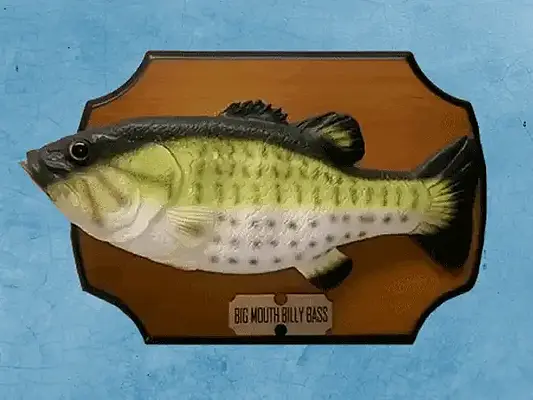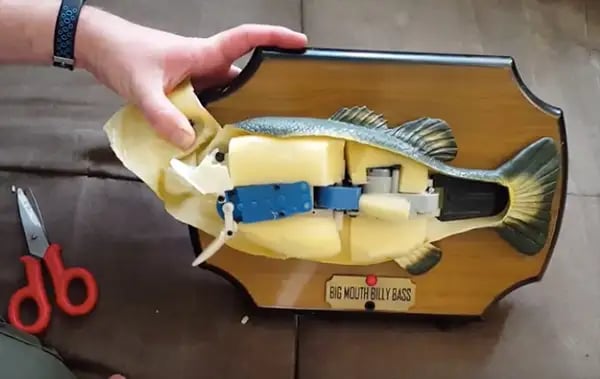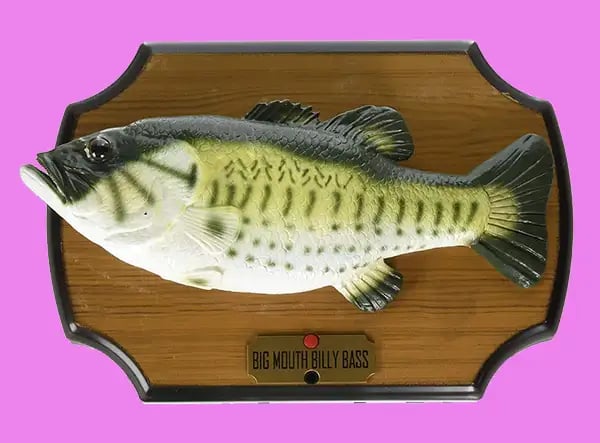In the year 2000, Big Mouth Billy Bass was inescapable.

The animatronic latex fish could be found floppin’ and singin’ on the shelves of every major retailer and toy store. It graced the walls of George Bush’s oval office and Queen Elizabeth’s Balmoral castle. It made a guest appearance on an episode of the Sopranos. And in the process, it sold hundreds of thousands of units.
But in an industry where few products hit it big, how did a plaque-mounted singing fish become one of the most iconic gag gifts in history?
It started with a guy named Joe
Joe Pellettieri began his career as a self-professed “numbers guy.”
After receiving his MBA in marketing and finance from Indiana University, he worked as a buyer for various department stores around the Midwest. But after a decade of retail work, he went looking for “the next big thing.”
That thing turned out to be Gemmy Industries, a small novelty toy business in Coppell, Texas, just outside Dallas.
When Pellettieri arrived at Gemmy in 1998, the company was peddling a mechanical sunflower named Sunny that sang “You Are My Sunshine.” But sales weren’t great.

Pellettieri had an idea: “I thought, why just one flower?” he recalls. “Why can’t we have a whole pot of flowers?”
Before long, Gemmy was selling a quartet of flowers movin’ and groovin’ to Glenn Miller’s “In The Mood,” and the company’s dancing and singing Living Garden Series was born.
The invention earned Pellettieri a promotion to VP of product development. But in the novelty toy industry, where success is short-lived, he soon found himself fishing for another winner.
The birth of Big Mouth Billy
As a new transplant in the product development world, Pellettieri hadn’t quite figured out the best way to find inspiration. Then, toward the end of ‘98, he took a fateful road trip with his wife, Barbara.
During a pit stop at a Bass Pro Shop Outlet, Barbara turned to him with an unusual proposal. “She goes, ‘How about a singing fish on a plaque?’” he recalls.
Most people would scoff at the idea. But Pellettieri sensed it had promise.
“I always come from a place of what makes me laugh,” he says. “The idea of a fish on a plaque singing ‘Take Me To The River’ was hilarious.”

Novelty toys are a notoriously fickle industry: Consumer tastes ebb and flow, and marketing experts say it’s virtually impossible to predict what causes a viral hit.
Seth Godin, a former dot-com exec and author of Purple Cow: Transform Your Business by Being Remarkable, believes a viral hit calls for the creation of a purple cow — something unique that stands out from the masses. This philosophy helped Furby sell over 40m units in its first three years (1998-2000), and made the fidget spinner a $500m industry in 2017.
Pellettieri had found his purple cow –– or, rather, his purple fish.
The creation of Big Mouth Billy wasn’t all sunny brooks and full fish hooks. When he initially pitched the idea, the higher-ups at Gemmy “hated the look”
But Pellettieri couldn’t shake his idea.
The breakthrough
For the better part of ‘99, Pellettieri worked and re-worked his concept. But, design after design, Pellettieri still wasn’t sure if this was one of those times he needed to walk away. “I would put my drawing of the fish up on the wall and just stare at it constantly. It wasn’t working,” he says.
That all changed with a not-so-simple question to Gemmy’s engineers in China: “Can you make the head turn?”
It may seem elementary now, but in the late ’90s few toys had actual mobility in their movements. Making a fluid movement up and down or side-to-side was one thing, but creating a motorized mechanism that allowed the head to turn out from the plaque? It had never been done successfully.

Neil Patel, a marketing consultant and New York Times best-selling author, writes about “thinking like a street magician” when it comes to going viral. The key is to keep the audience wanting more. In Neil’s words, David Copperfield combines elements of story-telling and visuals in each trick that build anticipation until the final reveal.
Billy Bass works on a sensor mechanism. Anytime someone walks by the scaley wall-singer, it starts to flail; before you know it, you’re graced with a sonic treat.
Big Mouth Billy’s mobility was the magic-like catalyst that kept audiences enthralled. And it’s what got the brass at Gemmy to finally sign off.
“The movement is what hooked [the execs],” Pellettieri recalls. “Then we were off to the races.”
But Joe knew that if this Cinderella story was actually going to find its glass slipper, he had to make sure the look was on point with the technology. And for that, he needed a team.
“If anyone in the product development world stands up and says, ‘Hey, look what I did,’ they’re full of shit,” he admits. “There were so many people involved –– artists, engineers, taxidermists, salespeople, US staff, Hong Kong staff… it was a team effort.”
A star is born
Dubbed the “Big Mouth Billy Bass,” Pellettieri’s product came to life in the summer of 1999 –– and retailers who saw the prototype loved it. By early 2000, Billy became a prized trophy in a slew of speciality stores.
Places like Bass Pro Shop, Spencer’s Gifts, and any other store that would charge Gemmy’s premium price of $29.95 were Billy’s first hatch zones.

With no advertising –– Gemmy only runs on word of mouth –– the company boosted profits with limited amounts of product in the beginning. Brought on by consumers, this organic reach helped Gemmy feel confident moving Billy into mass market retailers like Walmart and Target. By Christmas of 2000, Billy was a full-blown phenom.
The early sales led the company to rapidly scale up production. But BIlly’s intricate electrical wiring needed 45 to 50 days of lead time, and the company was forced to predict the toy’s value 2 months down the line. Gemmy ran the risk of over-production –– a costly mistake that could have left the company with warehouses full of unsold toys (AKA toy purgatory).
Riding the wave
Billy soon shot to global stardom: DJs jammed out to the “fish song,” kitschy restaurants used the synthetic, scaly singer as a gimmick to put butts in seats, and Bill Clinton even reportedly shipped one to Al Gore.
As much as one could in the new millennium, Big Mouth Billy was riding the influencer train. Just as Pellettieri had predicted, the toy caught consumers hook, line, and sinker.
At one point, Big Mouth Billy was swimming off the shelves of secondary markets like eBay for as much as $90 a pop –– 3x its list price. It was an astonishing figure, considering that each Billy only cost an estimated $4.50 to produce.

But Big Mouth Billy Bass was no exception to the novelty world’s live-fast, die-faster reality. As the leaves changed in the fall of 2001, so did consumer demand for a musically gifted robotic bass that lacked the ability to pick up on social cues at parties.
In a short time, Billy was selling for $5 in Walmart clearance bins. The flame had gone out.
The toy’s lead creator, too, had moved on. “I had my 15 minutes of fame,” Pellettieri says. “It was time to get moving to the next thing.”
Post-bass
Today, Pellettieri and Gemmy maintain a CIA-like secrecy when it comes to divulging the fish’s financials. But it has been rumored that Big Mouth made the company over $100m in revenue, and sold more units than the popular red furry fellow from Sesame Street (Tickle Me Elmo) during its 9-month run in 2000.
In the post-Billy era, Gemmy has had many plaqued-animal spin-offs, including a short-lived Christmas-themed Billy. But, Pellettieri didn’t want to get stuck being known as the “singing fish guy.” To him, it was important to keep innovating.
One of his big creations, Kung Fu Hamsters that sang Carl Douglas’s “Kung Fu Fightin,” came in his latter years at the company and, according to Pellettieri, was Gemmy’s most popular hit behind Big Mouth Billy.
Pellettieri left Gemmy in 2010, and now serves as VP of product development at another Texas-based seasonal toy company, Occasions Limited, where he has been granted even more creative freedom (he’s currently working on Halloween of 2021).
With Big Mouth Billy Bass, Joe Pellettieri created not just a novelty toy, but a viral (before ‘viral’) sensation that tapped into some deep abyss of the human psyche and answered a call we never knew we had (even if it did make us want to destroy it with a sledgehammer in the end).
But he’s still the same guy, looking to make people smile with his products –– and always hunting for the next big fish.

